If there’s one clear sign of climate change, it’s extreme heat. And people all across the US know it as they have been facing it this summer with long heat waves. According to new research, this will likely be the new normal across the country.
Climate change will probably make extreme heat conditions and their health risks much more frequent in almost every part of the US, according to research published in the journal Environmental Research Communications.
“Our analysis shows a hotter future that’s hard to imagine today,” study co-author Kristina Dahl, a climate scientist at the Union of Concerned Scientists, said in a statement. “Nearly everywhere, people will experience more days of dangerous heat in the next few decades.”
By 2050, hundreds of US cities could see around 30 days each year with heat index temperatures above 100 degrees Fahrenheit (37.7 Celsius) if nothing is done to rein in global warming. The heat index is what the temperature feels like to the human body when relative humidity is combined with the air temperature — so it’s a measure of how temperature actually feels.
This is the first study to take the heat index — instead of just temperature — into account when determining the impacts of global warming. The number of days per year when the heat index exceeds 100 degrees will more than double nationally, according to the study.
“We have little to no experience with ‘off-the-charts’ heat in the U.S.,” said Erika Spanger-Siegfried, lead climate analyst at the Union of Concerned Scientists and report co-author. “These conditions occur at or above a heat index of 127 degrees. Exposure to conditions in that range makes it difficult for human bodies to cool themselves.”
The research suggests that there will be few areas of the country able to avoid these extreme heat events, except for some high-altitude mountainous regions. Currently, the only place that experiences these “off-the-charts” days is the Sonoran Desert on the border of southern California and Arizona.
The National Weather Service of the US typically issues a “heat advisory” when a maximum heat index is expected to hit at least 100°F for two or more days, and an “excessive heat warning” when it will hit at least 105°F for two or more days. These heat levels can lead to health risks such as dehydration and heatstroke.
The expected increase in heatwaves will require additional efforts to help people cope, especially those who aren’t used to it, the study concluded. This should be in line with a further reduction in global greenhouse emissions, now considered not sufficient to meet the 2ºC global warming limit established by the Paris Agreement.










